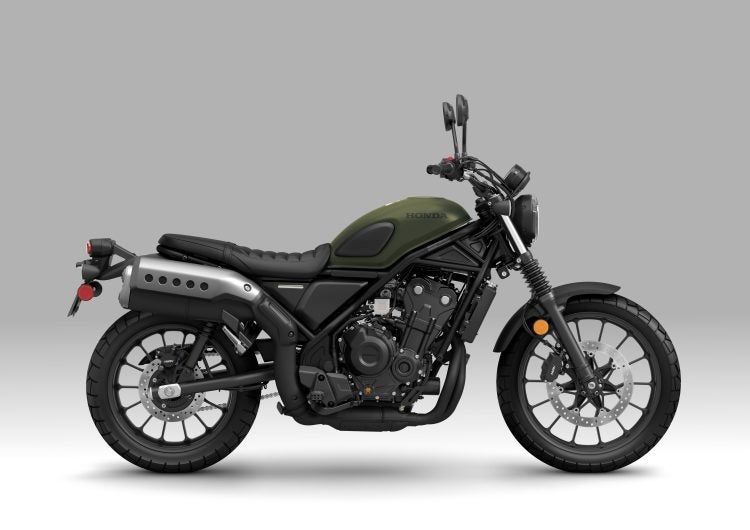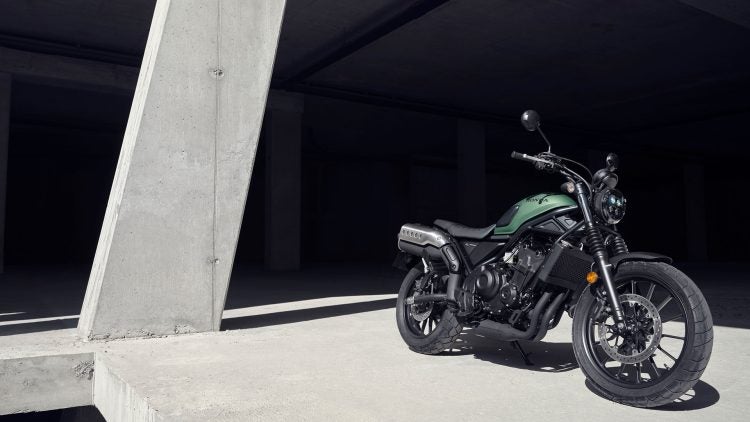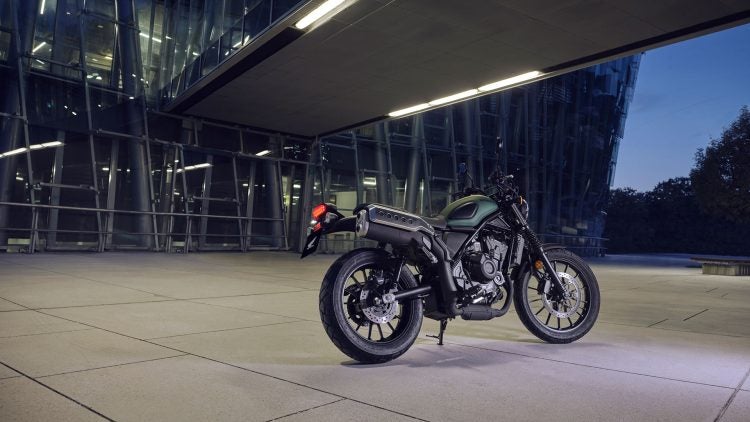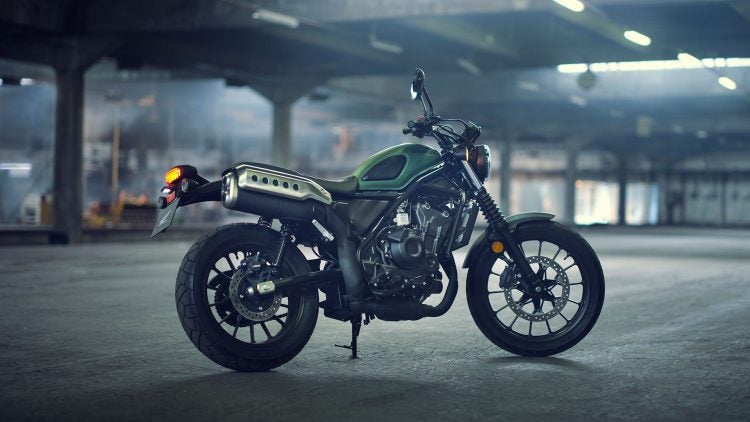A Honda is a Honda is a Honda. Hell, I could ride a fleet of motorcycles while blindfolded and still tell you which of them are Hondas. (Need I add that the previous sentence contains the caveat professional rider closed course?) But how can a Honda be so easily identified? Especially since the Japanese big four make motorcycles with overlapping characteristics. Often eerily so. Back when sporting 600s were all the rage, the four competing motorcycles from the four competing Japanese brands had the exact same bore and stroke. So much for originality. But even with that said, a Honda is still a different animal. And the humble SCL500 is no different.
It comes down to this: a Honda wants you to be a better rider. Things that are of little consequence to other brands are deal-breakers on a Honda. Little things like the clutch engagement point. (I warned you these things were little.) A Honda will not embarrass you by stalling at a stoplight. Details experienced riders rarely think of. But to a beginner, stalling a bike in city traffic is as horrifying as a pilot flying below stall speed.
Hondas are not visceral motorcycles. They’re not meant to be. They’re designed to be cooperative companions. And no motorcycles are more lovingly supportive than Honda’s 500 twins. Comprised of a model range that ranges from mild to milder, the same 471 cc parallel-twin powers the mildly-sporting CBR500R, the mildly-naked CB500F, the mildly dirt-curious CB500X, the absolutely un-rebellious Rebel 500 and, as of this season, the bike we’re focused on here—the SCL500 Scrambler.

Honda, at the bike’s Ventura, California, launch (my invitation was misplaced in the post) made great pains (so I’m told) to link the Scrambler to Honda’s CL72/77 of the 1960s. Let’s look at the details that would inspire Honda to make such a claim: the old bike has a high-routed exhaust pipe and the new bike has a semi-high routed exhaust pipe. That’s it, pretty much. Let’s move on.
The important stuff first: colors. My test bike is matt laurel green metallic. A color de jour in 2023. The second of two colors is a candy orange. You can’t go wrong with either. As far as the dirty bits go, it will come as no surprise to anyone that the Scrambler is mostly based on the Rebel 500. The Scrambler gets a different subframe—to move the seat off the ground to a height of 31.1 inches, an up-from-terra-firma height that works for people who actually have legs.

Here’s an oddity of the spec sheet. The Scrambler has slightly more suspension travel than the CB500X adventure bike. With 5.9 inches up front and 5.7 inches out back, the Scrambler does a decent job of soaking up the worst of miserable road conditions. However—however—the fork is on the soggy side of life, and, since it’s not adjustable, it will remain soggy. But the Scrambler isn’t any more of a canyon-carver than it is a hardcore motocrosser. And, truthfully, the fork settings are absolutely ideal for its intended use. So, please, ignore this entire paragraph.
Onto the sexy bits. Clutch pull. If I was on my dry-clutch Ducati and felt this little tension when I pulled in the lever, I’d expect to look down and see hydraulic fluid leaking onto my boot from the slave cylinder. But this is a Honda. One finger will suffice. If you can ride a bicycle, you can ride the Scrambler. And that’s the point of this bike. The clutch also has a slip/assist function. Which means that no matter how ham-fisted you are with your downshifts, you’ll be fine. Just fine. Honda fine.

With horsepower likely in the 40s, the little parallel-twin is perhaps the perfect compromise between “don’t scare the beginners” and “enough grunt not to die on the interstate.” It’s an engine that lacks nearly everything: heat, noise, vibration—and even fuel consumption: riding like an idiot I still managed mid-60s mpg.
The Scrambler moves out smartly from stoplights, shifts with the ease of a drunk pounding down a bottle of rot-gut wine, and marches the 419-pound (claimed, wet) Scrambler up to the speed limit with ease. More than the speed limit is available, of course, but what’s the rush? Seventy mph is possible, but the wind noise through your off-brand retro helmet is unpalatable at that speed. I saw 80 mph on the speedo but that was only because I was on the highway and had to make it to a rest stop because I desperately had to pee.
A retraction: I wrote that I “saw” 80 mph on the speedo. And that’s true. Sort of. The circular LCD gauge is so dim that unless you restrict riding to the midnight hours, it’s very nearly illegible. But if you have the vision of a cat, you’ll be able to see gear position, a clock, trip meters, fuel level, average mpg, instant mpg, and, for those of you who live dangerously, a reserve trip meter.
Now, about that exhaust pipe. Yes, that’s what’s bugging you. I get it. The only equivalent I have to the Scrambler’s flat-black exhaust system was buggered-up plumbing in an old house I once owned. The kind of disaster in which the “plumber” was adamant that no trip be made to the hardware store for a length of ABS the correct diameter. The pipe in the old house vacillated nonsensically from inch-and-a-half to four-inch and back again. Flushing the toilet was a fresh adventure each time. “But why can’t it look like the chrome pipes on Honda’s old Scramblers,” the disgruntled have been howling in chorus. Easy. Euro exhaust emissions. It’s the new reality. I don’t like it any more than you do.
But having said lots of middling things about the Scrambler, I need to say this. It’s perfect—for its intended use. Yes, the single front rotor and two-piston caliper isn’t going to drive Brembo out of business, but you can grab a fistful and stop the bike decently well. And, don’t forget, grabby front brakes scare the daylights out of new riders. ABS is standard. As it should be on all bikes.

If you’re coming from a cruiser, with its porky tires, to the Scrambler, you’re in for a surprise. Skinny tires are where it’s at. The 110/80 19-inch Dunlop Trailmax Mixtour-clad front wheel facilitates handling like a bicycle. Truly, it doesn’t feel like any pressure on the broad handlebar is necessary. Just look where you want to go and—bingo!—you’re there. And because two wheels are a necessity on a motorcycle, the 17-inch rear wheel with its 150-section tire is meaty enough to get the business to the ground. Some misanthropes have groused about the Scrambler’s 3.2-gallon fuel tank. Say what? You’re not going to run Dakar on this thing. At most you’re riding to the next town.
With a price of $6,799 USD ($9,100 Canadian), the Scrambler is a very Honda way to get onto two wheels. And, for my money—just a figure of speech, I’m not in the market—the Scrambler is a much better option for people of reasonable inseam than the Rebel 500. Firstly, it’s not as awkward looking as the Rebel, and it puts the rider in a more comfortable and controllable seating position. And the “scrambler” aura just makes it feel more robust. You and I know they’re both the same bike, but not everyone needs to know our secret.







